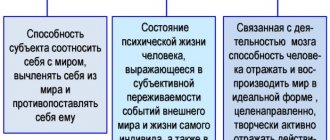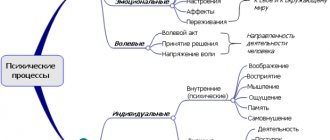Attention: properties, functions and types
Attention is the focus of the psyche on certain objects, concentration on them. Attention
- a psychophysiological process, a state that characterizes the dynamic features of cognitive activity, which are expressed in its concentration on a relatively narrow area of external or internal reality, which at a given moment in time become conscious and concentrate the mental and physical forces of a person for a certain period of time.
Attention
- this is the process of conscious or unconscious (semi-conscious) selection of some information coming through the senses and ignoring others.
Five basic properties of attention:
1. stability,
2. concentration,
3. switchability,
4. distribution,
5. volume.
Sustainability of attention
- the ability to maintain a state of attention for a long time on any object, subject of activity, without being distracted or weakening attention.
Focus
(the opposite quality - absent-mindedness) - manifests itself in differences, in the degree of concentration of attention on some objects and its distraction from others.
Switching attention
- transfer of attention from one object to another, from one type of activity to another. It manifests itself in the speed with which he can transfer his attention from one object to another, and such a transfer can be either involuntary or voluntary.
Distribution of attention
- the ability to concentrate attention over a significant space, perform several types of activities in parallel, or perform several different actions.
Attention span
- the amount of information that can simultaneously be stored in the area of increased attention (consciousness) of a person.
The numerical characteristic of the average attention span of people is 5-7 units of information.
Attention functions:
- activates necessary and inhibits currently unnecessary psychological and physiological processes,
- promotes the organized and targeted selection of information entering the body in accordance with its current needs,
- provides selective and long-term concentration of mental activity on the same object or type of activity.
- determines the accuracy and detail of perception,
- determines the strength and selectivity of memory,
- determines the direction and productivity of mental activity.
- is a kind of amplifier for perceptual processes, allowing one to distinguish the details of images.
- acts for human memory as a factor capable of retaining the necessary information in short-term and operative memory, as a prerequisite for the transfer of memorized material into long-term memory storage.
- for thinking it acts as an obligatory factor in correctly understanding and solving a problem.
- in the system of interpersonal relations promotes better mutual understanding, adaptation of people to each other, prevention and timely resolution of interpersonal conflicts.
- An attentive person is described as a pleasant interlocutor, a tactful and delicate communication partner.
- An attentive person learns better and more successfully and achieves more in life than someone who is not attentive enough.
Main types of attention:
- natural and socially conditioned attention,
- direct and indirect attention,
- involuntary and voluntary attention,
- sensory and intellectual attention.
Natural attention
- given to a person from his very birth in the form of an innate ability to selectively respond to certain external or internal stimuli that carry elements of information novelty (indicative reflex).
Socially conditioned attention
- develops during life as a result of training and upbringing, is associated with volitional regulation of behavior, with a selective conscious response to objects.
Direct attention
- is not controlled by anything other than the object to which it is directed and which corresponds to the actual interests and needs of a person.
Vicarious attention
- regulated using special means, such as gestures, words, pointing signs, objects.
Involuntary attention
- is not associated with the participation of the will, does not require effort in order to maintain and focus attention on something for a certain time.
Voluntary
attention
- necessarily includes volitional regulation, requires effort in order to maintain and focus attention on something for a certain time, is usually associated with a struggle of motives or impulses, the presence of strong, oppositely directed and competing interests,
Sensory
attention is
associated with emotions and the selective work of the senses, in the center of consciousness there is some sensory impression.
Intelligent attention
- predominantly associated with the concentration and direction of thought, the object of interest is thought.
Forms of attention disorders:
1. Increased distractibility
– excessive mobility of attention, constant transition from one object and type of activity to another;
2. Reduced attention span;
3. Inertia (low mobility) of attention
– inability to quickly switch in a timely manner or pathological fixation of attention;
4. Hypo- and aprozexia
–
inability
to focus attention on anything
for the required period of time and complete loss of attention.
attention types of attention
Attention and consciousness
Previous6Next
The problem of the connection between attention and consciousness began to be developed within the framework of philosophy, and, above all, Eastern philosophy. It is in it that a special place of attention is noted - as “kon, “penetration” - in achieving enlightenment, true divine wisdom. “Enlightened consciousness” is impossible without attention. It is no coincidence that the technique and practice of meditation, also based on the utmost concentration of consciousness, develops precisely in the Eastern religious and philosophical tradition.
In psychology, a line of research emphasizing the connection between attention and consciousness began to actively develop in the second half of the 19th century. The first direction within which the systematic experimental study of attention began was the classical psychology of consciousness . Since then, psychology has developed a number of different ideas about the relationship between attention and consciousness, in which attention is assigned a variety of roles.
Perhaps the most common idea of attention in modern attention psychology is its interpretation as a mechanism of access to consciousness , which determines what of what we perceive and experience at the moment will reach consciousness and influence our behavior, and what may pass by. The question of what and why remains outside consciousness occupies an important place in modern psychology of attention.
In classical psychology of consciousness, several more approaches to considering the relationship between attention and consciousness were outlined. In one of them, consciousness appears as a structure similar to the visual field with focus and periphery, and attention as part of consciousness, its focus , the zone of greatest clarity and distinctness of the contents of consciousness.
Finally, attention can be considered as one of the properties of consciousness or its inherent features. This property is the degree of subjective clarity of impressions in the mind, which, in the case of insufficient attention, turn out to be vague, and in the case of extreme attention, appear most clearly to a person [Falikman, 2006].
R. Solso defines consciousness as knowledge about events or environmental stimuli, as well as knowledge about cognitive phenomena (memory, attention, bodily sensations) [Solso, 2006].
Endel Tulving identified three types of consciousness in humans:
1) anoetic (“not knowing”) consciousness is limited in time by the current situation; it allows a person to record signs of the environment and respond with his behavior to this situation;
2) noetic (“knowing”) consciousness allows a person to be aware of objects, events and their relationships in the absence of these objects and events;
3) autonoetic (“self-aware”) consciousness is the most complex; it is necessary for remembering personally experienced events [ill. from: Solso, 2006].
Thus, three main objects of attention were indicated.
It makes sense to consider consciousness in the context of attention because both of them have one common property - limited bandwidth.
A person selectively directs his attention to a certain part of all available signs. It is assumed that there is a bottleneck somewhere in information processing, partly due to neurological capabilities. Studies of selective attention and bandwidth were conducted using auditory and visual signals.
K. Cherry's research made it possible to develop an experimental procedure called shading (the term is borrowed from the technique of painting: to shade something means to highlight it from its surroundings).
During this procedure, the subject is asked to repeat the message exactly as it was presented. However, K. Cherry's experiments had one more feature: two auditory messages were presented simultaneously - one of them should be “tinted”, and the other should be ignored. Sometimes these messages were presented through headphones, sometimes through speaker systems located in different places.
As a result, the scientist discovered that the message that was not given attention was remembered much less well. The ability to focus on one message is an important human property, as it allows one to process a limited amount of information without overloading the processing mechanism [Solso, 2006].
Previous6Next
Date added: 2017-06-13; views: 1340; ORDER A WORK WRITING
Similar articles:
Sustainability of attention
Stability lies in the ability to focus on one object for a certain time, so it is a temporary characteristic of attention. This property of attention can be determined by peripheral and central factors.
Research has shown that attention is subject to periodic involuntary fluctuations. According to N.N. Lange, periods of such oscillations are usually 2-3 seconds and reach a maximum of 12 seconds. If you try to concentrate on the ticking of a clock, you will sometimes hear it, sometimes not. Oscillations when observing more complex figures are of a different nature. In them, first one and then the other part will alternately appear as a figure. For example, an image of a truncated pyramid will give this effect. A truncated pyramid is shown in the figure:
Finished works on a similar topic
- Course work Characteristics of the properties of attention 430 rub.
- Abstract Characteristics of the properties of attention 240 rub.
- Test work Characteristics of the properties of attention 190 rub.
Get completed work or advice from a specialist on your educational project Find out the cost
If you look at the pyramid for some time, it will alternately appear convex and concave. Small periods of fluctuations in attention are not a general pattern. The most essential condition for sustained attention is the ability to reveal new aspects and connections in a subject.
When attention is unstable under all conditions, more or less effective mental work would be impossible. The stability of attention also depends on other conditions - the degree of complexity of the material and the difficulty of getting to know it, the understandability of the material, the subject’s attitude towards it, the individual characteristics of the individual.
The stability of attention can be checked using the Bourdon table. It consists of a random alternation of individual letters. In each line, each letter is repeated the same number of times. The subject must cross out given letters for a long time. The stability of attention is similarly tested using Kraepelin tables. They consist of columns of numbers, and the subject must add them for a long time. The number of errors made and work productivity are indicators of fluctuations in attention.
Too lazy to read?
Ask a question to the experts and get an answer within 15 minutes!
Ask a Question
Concentration of attention
Definition
Concentration is the next property of attention, which implies the intensity of concentration.
Concentration of attention, believed A.A. Ukhtomsky, is associated with the peculiarities of the functioning of the dominant focus of excitation in the cortex. In his opinion, this is a consequence of excitation in the dominant focus with simultaneous inhibition of other areas of the cerebral cortex.
Since attention can be voluntary and involuntary, then, accordingly, concentration of attention is produced both by an effort of will and by itself, based on personal interest. Maintaining attention for a long time in the first case requires a large amount of energy, which can lead to exhaustion. Concentration will be less tiring if it is based on interest in the object and leads to greater productivity. Naturally, engaging in activities that arouse genuine interest is very important for a person.
The ability to focus on a specific object develops with age. It is difficult for kids to concentrate for a long time, but younger schoolchildren can sit through lessons without any problems. Thus, they acquire the ability to learn. By concentrating on one subject for a long time, the child gradually gets used to the loads and copes with them more easily, and by the end of school he is already fluent in voluntary attention.
There are many exercises to develop concentration, for example, brain impulses, the center of the universe, counting, etc.
Switching attention
Definition
Switching is understood as a conscious and meaningful movement of attention from one object to another.
In general, this means the ability to quickly navigate a complex, changing situation.
The ease of switching varies from person to person and depends on a number of conditions. First of all, this is the relationship between previous and subsequent activities, as well as the subject’s attitude towards each of them.
It is much easier to switch to an interesting activity and vice versa. Switching attention is well trained.
Attention span
Volume is another property of attention and represents the number of objects that a person can cover simultaneously with sufficient clarity.
As we know, a person cannot think about different things and perform different tasks at the same time. Such a limitation forces information coming from outside to be split into parts without exceeding the capabilities of the processing system.
During learning and training, the volume of attention practically does not change, and its indicator is the number of clearly perceived objects. Different people have different attention spans. This depends on the extent to which the content on which attention is focused is interconnected, as well as on the ability to meaningfully connect and structure the material. The scope of attention is very close to the concept of the scope of perception.
Distribution of attention
Definition
Distribution of attention is a person’s ability to simultaneously perform several types of activities.
Of course, the classic example of such ability is Julius Caesar. Tradition says that he could do seven unrelated things at the same time. It is also known that Napoleon could simultaneously dictate seven important diplomatic documents to his secretaries.
Practice, however, shows that a person can perform only one type of conscious mental activity. The subjective feeling of doing several things at the same time arises because a person quickly and consistently switches from one type of activity to another. As W. Wundt proved, a person cannot simultaneously concentrate on two presented stimuli. However, sometimes a person is actually able to perform two types of activities, but, in this case, one of the types should be completely automated and not require attention. If this condition is not met, combining activities is impossible. The distribution of attention, as a number of authors believe, is the reverse side of another property - switchability.










